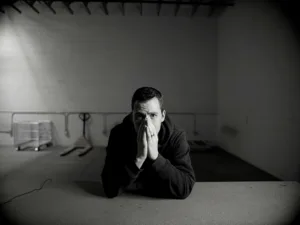If you’re like many men, you started therapy with a specific goal in mind. Maybe you wanted help coping with a hard season of life or getting over an issue that was bothering you. Now, you’ve been in therapy for a while and you’re starting to feel better. You’ve got a toolbox full of tactics and practices to help you cope.
Is it time to say goodbye to your therapist?
The answer is: It depends.
In this blog, we’ll explore the benefits of staying in therapy, how to measure “success,” and how to know when it’s time to leave.
The Benefits of Therapy for Men
Men in Colorado — where the suicide rate is above the national average — men are three times more likely than women to die by suicide. More than 6 million men suffer from depression. Yet only about one-third of people in therapy are men. For men, getting into therapy is often the most challenging hurdle to jump on the road to improved mental health.
Once in the door (literal or virtual), men who work with a qualified therapist often find relief and solutions. They also see tangible results to common men’s mental health — they’re less angry, better able to cope with disappointment, and feel generally “unstuck.”
The Phases of Therapy
The purpose of therapy is to address the core issues causing your symptoms. Therapy often follows a predictable pattern or phase cycle.
- Getting to know each other. You and your therapist will discuss what has brought you in. It’s during this phase that you’ll get a sense of whether you’re a good therapist/patient fit for one another. Sometimes personalities don’t mesh and that’s okay. Good therapists are never offended or resentful if you choose to try someone else.
- Setting goals. Once you’ve established a rapport, it’s time to decide what you want to achieve during your time in therapy. Your therapist will walk you through what might be possible and begin to help you establish a few grounding practices and strategies — like breathing exercises, meditation practices or whatever makes sense for you. You’re building your toolkit during this phase.
- Addressing core issues. This is where a good chunk of the work happens. You have some tools for symptom relief but the work of addressing the core of what led you to therapy is less about figuring out how to cope with symptoms and more about finding a path toward healing. Your therapist will work with you to develop a plan of action that addresses your initial goals.
- Revisiting goals. As you progress through your therapy journey, you and your therapist will regularly revisit the goals you set in the beginning. It’s a way to track your progress and make sure the hard work you’re doing is paying off.
- Termination. Therapy isn’t usually meant to go on forever. The final phase of therapy is called termination. If you’ve met your goals — both those you came in with and any additional goals that may have arisen during the therapy process — it may be time to terminate. This isn’t an abrupt process. Your therapist will suggest a schedule of slowly ramping down sessions in a way that is comfortable for you.
Maximizing Your Time in Therapy
When you start to feel good, it can be tempting to end your therapy sessions abruptly. This can often happen during phase two, where you’ve received coping strategies and tools to deal with the most pressing symptoms.
But therapy — and life — are rarely so straightforward. Even if you’re feeling better about conquering one challenge life threw at you, chances are another one is right around the corner. Sticking with therapy through all of the stages ensures you’re addressing core issues rather than simply learning to cope with surface symptoms.
For men who have suffered from significant trauma dating back to childhood, the hard work that happens in phase three and beyond can be especially valuable. Even if you’ve made progress on behavioral or relational issues, staying connected to your therapist can help as new trauma-related challenges arise.
Men with mental health diagnoses like bipolar disorder, schizophrenia or borderline personality disorder may also benefit from staying in therapy even as symptoms improve. If you’re taking medication for mental health conditions, therapy can improve functional outcomes.
Other benefits of staying in therapy long-term:
- It’s a place to be totally honest. A therapist’s office is one place where it is okay (and encouraged) to be totally honest. There, you get to speak the truth and that can be liberating.
- It’s a place to focus on yourself. It’s easy to shove self-care to the bottom of the to-do list, especially if you have a demanding job or kids in the mix. Therapy offers you time and space to care for your mental and emotional health.
Your Therapist Wants Feedback
It can be tempting to think of your therapist as an old-school authoritarian coach. He gives you the drills, you do them. Instead, think of your therapist as your teammate. You’re there to work toward your goals together. It’s not only appropriate but helpful to provide your therapist with feedback about how the work is going for you. The back-and-forth dialogue is a major component of successful therapy.
How to Judge the Success of Therapy
Unlike at your physician’s office, there’s no blood test or x-ray that can determine if you’re fully “healed.” But, there are ways to measure how well your therapy is working.
You feel better. When you started therapy, you may have felt weighed down, anxious or angry. How do you feel now? Have those feelings lessened? Are you happier than you were at the start?
CAUTION: Remember phase two? You may be feeling better as you address some of those surface symptoms, but haven’t yet hit the core issues that were creating them. If you find yourself feeling better after one or two sessions, dig into your motivation for wanting to end therapy. Are you avoiding the big issues (the hard work) that will help you meet your goals?
Your scores have improved. You may have taken an assessment like the GAD for anxiety or the PHQ9 for depression at the beginning of your journey toward mental health. Take them again now and compare your results.
You do things differently. Actions are often a good indicator of mental health improvement. For example, if symptoms of depression kept you stuck in your bed most mornings, but now you’re able to get up and get on with the day — that’s a marked improvement. If you couldn’t make it through the morning commute without road rage, and now you’re screaming less — that’s improvement, too.
You’re coping better. Your life circumstances may not have changed dramatically from when you entered therapy, but you may be better able to cope with them now using the tools learned in therapy.
Your friends and family notice a change. It can be hard to track our own progress. Those who know and love you best can often point out the improvements made through therapy. Is there less conflict at home? Has your wife mentioned that you seem calmer? Have your coworkers noticed an increased level of confidence? These are all indications that therapy is working.
You have hope. Trauma and mental illness can cloud your vision for the future. You may feel numb, apathetic or like there is nothing to look forward to. As you work with your therapist, you may begin to feel gratitude again, hope for the future and joy in being alive.
Knowing When to Leave
There is no hard and fast rule for how long you should be in therapy with a counselor who is supportive and helping you progress. There are, however, a few clear signs you should leave immediately:
- You’re not clicking with your therapist. Therapists are people too, and sometimes personalities just don’t match. There’s no shame (and should be no hard feelings) if it’s just not working out. You can always look for a specialized therapist for men who might relate to your issues in a different way.
- Your therapist is unreliable. Whether because of overscheduling or disorganization, if you can’t rely on your therapist to keep appointments or communicate appropriately, it may be time to move on.
- You have a bad therapist. If your therapist is inappropriate or behaves unethically, cut ties and consider filing a report with the state’s professional licensure board.
In the above cases, ending therapy altogether is likely not the solution. Sometimes it takes time to find the right therapist for you. Don’t give up!
But what about if you’re clicking with your therapist and making progress? How can you tell if you’re done with therapy?
In the simplest terms, therapy is done when you’ve met the goals you set out to achieve and when you and your therapist feel you’re ready — whether that’s six weeks, six months or six years.
That’s when it’s time to enter the termination phase of therapy. According to the APA, termination is “the conclusion of treatment.” It can be initiated by the client or therapist and may be immediate or prolonged. “In the latter case, a date for the final session is established and sessions are sometimes scheduled less frequently over the intervening period.”
Start by talking openly with your therapist about the progress you’ve made. You can revisit your plan for termination and have a conversation about the steps you’ve made toward those goals. Your therapist may suggest you taper off sessions rather than quit all at once.
The Bottom Line
If you feel it’s time to exit therapy, talk to your therapist and come up with a plan. Remember, though, there’s nothing wrong with staying in therapy — even (and especially) when things are going well.
Therapy is not just for crisis management. It is a useful tool to deal with stress, cope with everyday problems and connect with someone who cares about what you’re going through.






